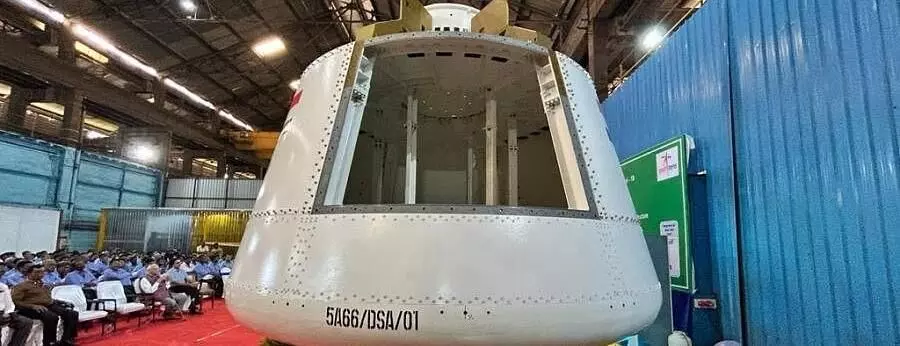
With launch of test vehicle mission, ISRO gears up for maiden human space flight programme
text_fieldsSriharikota: The first crew module test to ensure astronaut safety will be carried out by ISRO here on Saturday, coinciding with the launch of a single-stage liquid rocket that will mark the beginning of the space agency's ambitious human space flight programme, Gaganyaan.
ISRO plans to launch people on a three-day Gaganyaan mission into space in a 400 km Low Earth Orbit and return them safely to Earth.
Unlike other missions by the Bengaluru-headquartered space agency, ISRO would attempt a successful launch of its Test Vehicle (TV-D1), a single-stage liquid rocket, scheduled to lift off from the first launch pad at this spaceport at 8 a.m. on October 21.
The Test Vehicle mission with this Crew Module is a significant milestone for the overall Gaganyaan programme as a nearly complete system is integrated for a flight test.
The success of this test flight would set the stage for the remaining qualification tests and unmanned missions, leading to the first Gaganyaan programme with Indian astronauts, which is expected to take shape in 2025.
The Crew Module System is a habitable space with an Earth-like environment in space for the crew.
It is of double-walled construction consisting of a pressurised metallic 'inner structure' and an unpressurised 'external structure' with 'thermal protection systems'.
It houses the crew interfaces, life support system, avionics, and deceleration systems.
It is also designed for re-entry to ensure the safety of the crew during the descent till touchdown.
The Crew Module underwent various testing at ISRO centres before it was integrated into the launch complex in Sriharikota, located about 135 km east of Chennai.
The entire test flight sequence on Saturday is expected to be brief as the Test Vehicle Abort Mission (TV-D1) will launch the Crew Escape Systems and Crew Module at an altitude of 17 km which are expected to make a safe touchdown in the sea, about 10 km from the eastern coast of Sriharikota.
They would be later retrieved by the Navy from the Bay of Bengal.
The TV-D1 vehicle uses a modified VIKAS engine with a Crew Module and Crew Escape System mounted at its foreend.
The vehicle is 34.9 metres tall and has a lift-off weight of 44 tonnes.
The structure of the TV-D1 flight is a single-walled unpressurised aluminium structure with a simulated thermal protection system.
The Test Vehicle D1 mission aims for an in-flight abort demonstration of the Crew Escape System with the newly developed Test Vehicle followed by Crew Module separation and safe recovery.
Mission objectives include flight demonstration and evaluation of test vehicles, crew escape systems, Crew Module characteristics, and deceleration systems demonstration at higher altitudes and its recovery.
Through this campaign, scientists aim to ensure the safety of the crew who would be actually sent in the Crew Module on an LVM-3 rocket on the Gaganyaan mission.
Scientists have also lined up a series of tests with the beginning of the TV-D1 flight programme on Saturday.
ISRO Chairman S Somanath had recently said similar kinds of abort missions would be conducted much before the human space flight programme.
The prerequisites for the Gaganyaan mission include the development of many critical technologies, including human-rated launch vehicles for carrying the crew safely into space, a life support system to provide an earth-like environment to the crew in space, and crew emergency escape provision.
The rocket to be launched into space would be a human-rated LVM 3 -- a vehicle that would carry the Orbital Module to an intended Low Earth Orbit of 400 km on the Gaganyaan mission.
However, for the Test Vehicle Abort Mission 1(TV-D1), the Crew Module is an unpressurised version and it has the overall size and weight of the actual Crew Module on the Gaganyaan mission.
The Crew Module has all the systems for deceleration and recovery, a set of parachutes among many others.
In the first test flight on Saturday, the Crew Module would capture the flight data for evaluation of the performance of various systems onboard to serve the scientists.
With PTI inputs























